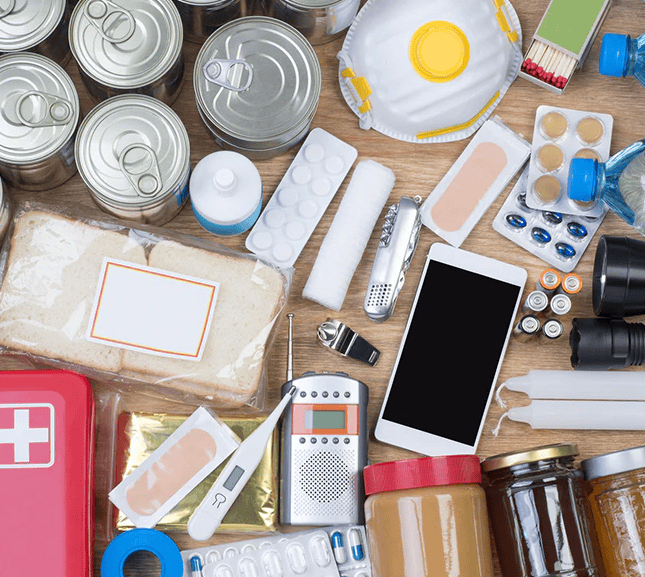Survival Kit Ideas in 2024
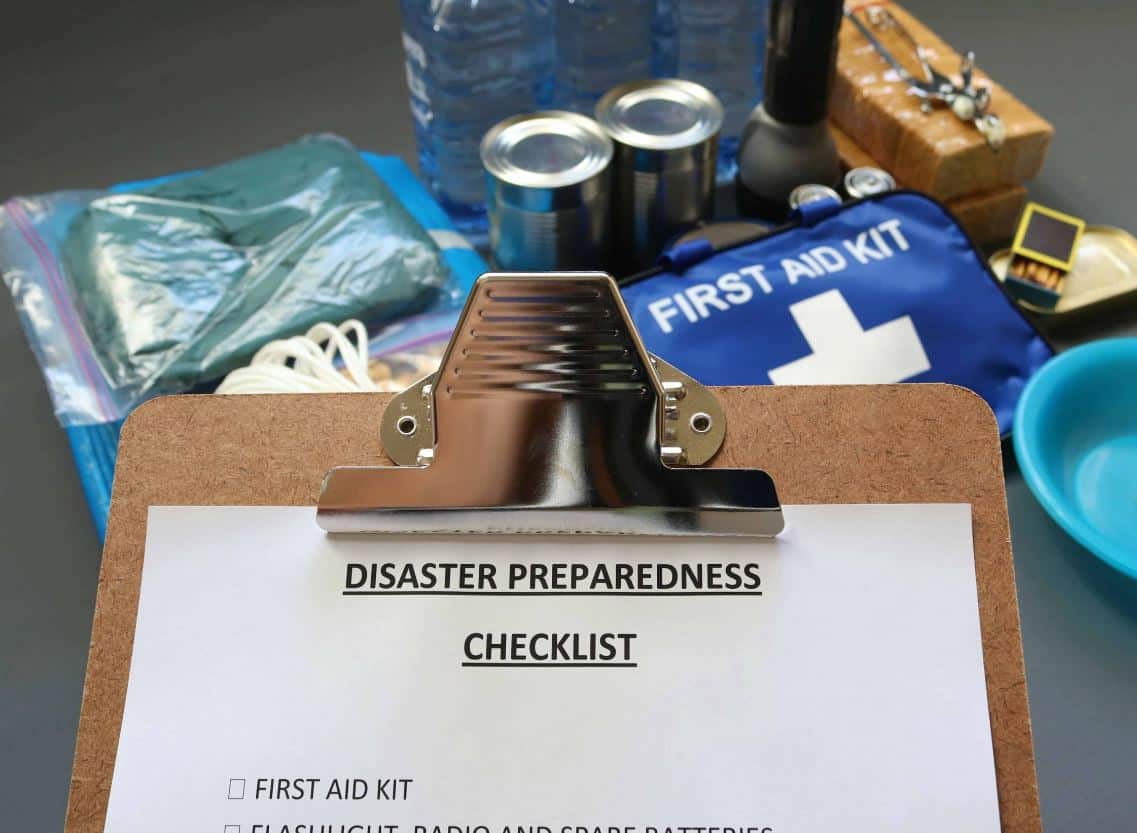
It’s a wild world out there. Just when it seems you’ve got a handle on things, life just throws a curveball out of nowhere. Natural disasters or sudden societal disruptions can catch anyone off guard.
Remember the fear during the early stages of the Covid-19 pandemic, the nuclear anxiety triggered by the Russo-Ukrainian war or the devastation caused by Hurricane Katrina?
The question isn’t so much if something will happen in the near future, but rather what specific challenge will come our way, and more importantly, if we will be ready for it.
Having a well-prepared survival kit seems more relevant than ever. And I’m not just talking about gear; it’s also about knowledge, mental readiness as well as peace of mind. The problem is that there are so many options out there in the field that it’s hard to know what’s really essential.
That’s why I’ve put together this introductory guide with the most important survival kit ideas for 2024, to try to help you get equipped, empowered, and prepared for many eventualities, whether you’re city-bound, a nature enthusiast, or just looking to keep your loved ones safe.
What are the best Survival Kit Ideas?
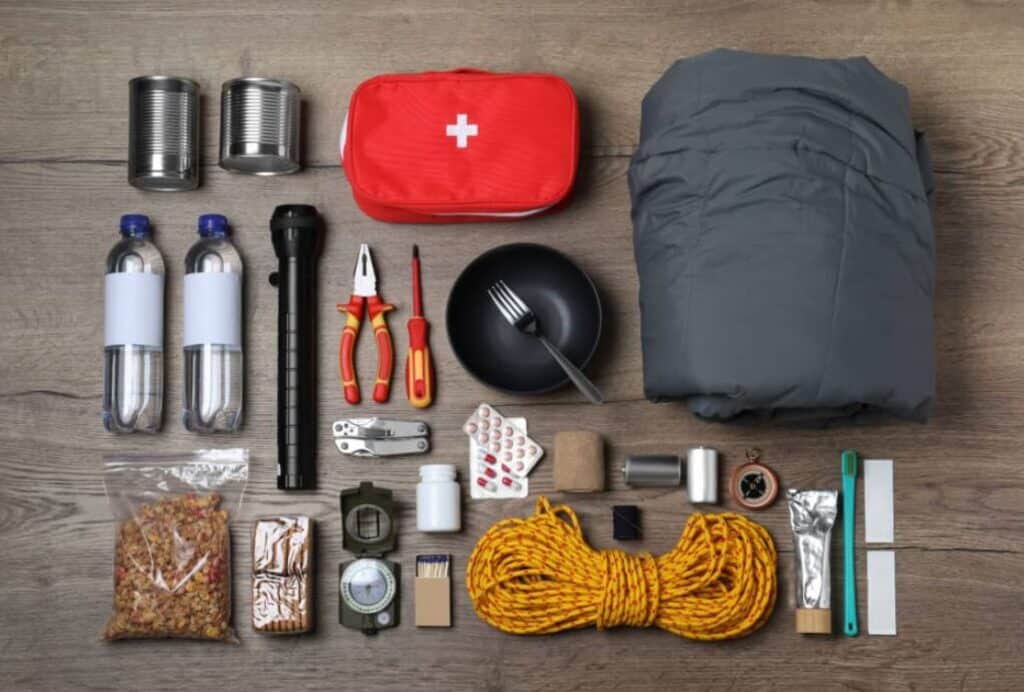
Before getting into the specifics, the key factors that should drive the development of the your survival kit are: versatility, reliability, simplicity, portability, and knowledge. Bear in mind that your goal is not to try to pack all the items for every possible scenario.
Rather, it is to choose versatile and reliable items that are easy to carry, can serve multiple purposes, and are straightforward for you to use – even in moments of great stress.
Your bug-out bag should always be fully stocked and immediately available for you to easily grab from a specific location or compartment.
- 1 – Water and Purification Essentials
- 2 – Emergency Food Supplies
- 3 – First Aid Kit
- 4 – Survival Tools
- 5 – Emergency Lighting
- 6 – Shelter and Warmth
- 7 – Personal Hygiene Items
- 8 – Urban vs. Wilderness vs. Natural Disasters
- 9 – Innovative Survival Gear
- 10 – Personalizing Your Kit
- 11 – Common Pitfalls to Avoid
- 12 – Emergency supply kit vs. Survival kit
1 – Water and Purification Essentials
If I had to rank the importance of each survival necessity, hydration would probably be on the top. We can only survive about 3 days without water, but several weeks without food, so there’s no hesitation in that comparison. And long before facing your demise, dehydration can also negatively impact your cognitive function, physical performance, digestion, and other key biological processes.
So make sure you have a nice stock of bottled water and two weeks worth of purification tools.
Recent technological advances in portable filters have also turned products from brands like LifeStraw into a popular option among preppers and outdoor enthusiasts.

2 – Emergency Food Supplies
In a survival situation, relying on external sources for sustenance isn’t always feasible. That’s why it’s essential to pack your own food in your survival kit, ensuring you have a reliable source of nutrition. Energy bars, freeze-dried meals, and MREs (Meals Ready-to-Eat) are some of the most classic survival kit ideas.
But you could also try to diversify with other food sources that have significant shelf lives and provide you with energy boosts, such as canned goods, grains, nuts, jerky, crackers, powdered drinks, or even honey.
And you may also want to consider a light, compact stove for heating.
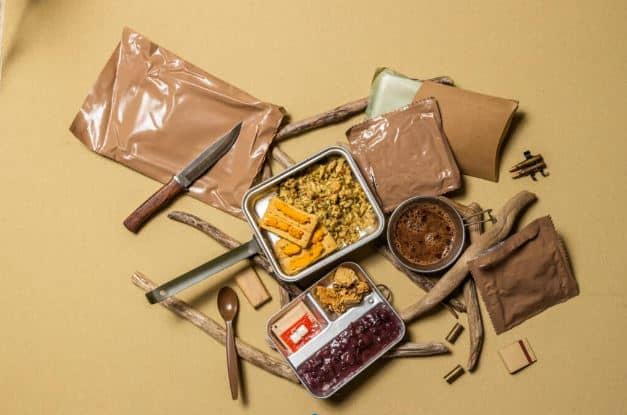
3 – First Aid Kit
During any emergency or survival situation, injuries can happen. Whether it’s a minor cut, a sprained ankle, or something more severe like a gunshot wound, being prepared with the right first aid kit and knowledge can make a significant difference.
There are multiple first aid kits on the market, but you can also develop your own kit to include at least bandages and gauze, antiseptics, gloves, tweezers, scissors, adhesive tape, pain relievers, and antibiotic ointment.
Additionally, you might also consider adding some allergy pills, a burn cream, and a First Aid Manual.
In addition to a good first aid kit, it is equally important to add to your knowledge some quality comprehensive first aid and CPR courses, like the ones offered by the American Red Cross.
Remember that there are situations where a quick and effective first aid response can be decisive.
As John “Lofty” Wiseman famously wrote in the book SA Survival Handbook, “The more we know the easier it is to survive. Knowledge dispels fear.”

4 – Survival Tools
Digging through the world of survival gear can be overwhelming, but the truth is that most items are basically irrelevant, while a few are absolutely indispensable.
Among these, the Swiss Army / multi-tool knife and the fixed-blade knife stand out as the best bet, offering a blend of versatility and reliability that few other tools can match.
The multi-tool knife should include a blade, screwdriver, scissors, tweezers, can opener, file, and even a saw. If you want to dig deeper, take a look at our review of multi-tool knifes.
The fixed-blade knife should be sturdy and relatively thick.
Another great versatile item is duct tape, which can be used in multiple situations for repairs, medical uses, shelter, and waterproofing, among others.
Super glue and an extra set of batteries might also come in handy.
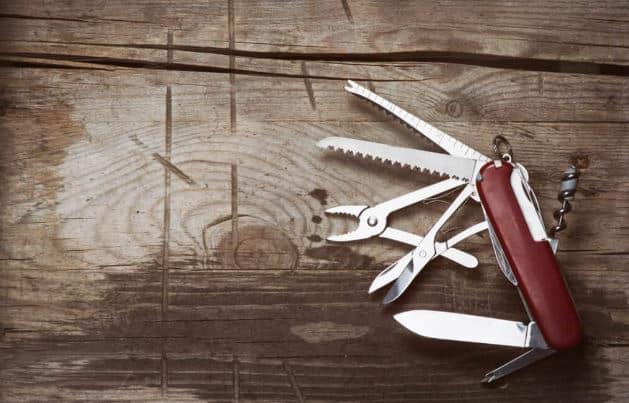
5 – Emergency Lighting
In survival situations, the importance of reliable lighting cannot be overstated.
It is absolutely crucial to have a dependable light source when you’re wandering in unfamiliar terrain, signaling for help, or simply trying to perform tasks in the dark.
Among the multiple lighting options, LED flashlights (preferably dual source, battery-powered, and solar panel or a hand-crank) and glow sticks are my favorites due to their efficiency, versatility, and lightweight.

6 – Shelter and Warmth
In survival scenarios, exposure to harsh environmental conditions can be one of the most immediate and pressing threats.
You could be facing the biting cold of a winter night, the relentless sun in a desert, or a sudden downpour, so having the means to protect yourself from the elements can be very important.
If you think shelter and warmth are just about comfort, think again: they can definitely mean the difference between life and death.
For this reason, it is vitally important to consider items like sleeping bags, emergency blankets, plastic sheeting (tarps), duct tape, hand warmers, water-resistant and weather-appropriate clothing, toilet paper, and perhaps even a compact tent.
And consider some waterproof matches, lighters, or some other kind of fire starter.
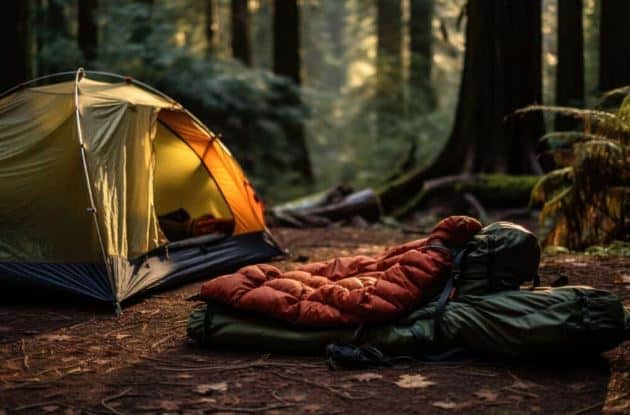
7 – Personal hygiene items
Carrying personal hygiene items might not seem like a top priority in a survival situation, but it plays an important role in ensuring your overall well-being and health.
Neglecting hygiene can lead to infections, skin issues, and other health complications, which can further compromise your ability to cope in already challenging circumstances.
Essential personal hygiene items include moist towelettes, hand sanitizers, compact toothbrushes and toothpaste, and feminine hygiene products. And perhaps a biodegradable soap and a small microfiber towel.
Personally I also like to include N95 masks in this category, given their preventative role against pollutants, pathogens, and other airborne particles. Certainly an important item when facing dust storms, wildfires, or even some disease outbreaks.
Make no mistake about this: staying clean can help boost your morale, keep you healthy, and increase your chances of survival.
8 – Urban vs. Wilderness vs. Natural Disasters
Survival situations can arise anywhere, from the heart of a bustling city like New York to a remote wilderness in the Appalachian Trail, or even in the comfort of your own suburban home during a natural disaster.
Each environment presents its unique challenges, and being prepared means tailoring your survival kit ideas to meet those specific needs.
Urban settings require greater focus, for example, on mobility tools and self-defense, wilderness on navigation tools and shelter, and natural disasters on communication devices and emergency lighting.
While there’s overlap in the essentials for any survival situation – like food, water, and first aid – the specifics of your environment dictate the tools and supplies you should prioritize.
9 – Innovative Survival Gear
As technology and research advance, the field of survival gear is continuously evolving, bringing forth innovative products designed to make emergencies more manageable and increase your chances of survival.
Staying updated with the latest gear ensures that you’re equipped with the best tools and knowledge to face any challenge.
In the last decade alone, we’ve been witnessing exciting advances in portable filters, ultra-light tents, bivvy bags, solar panel chargers, hand-crank radios and generators, satellite messengers, weather radios, survival watches, and others.
The world of survival gear is more dynamic than ever, with innovations continuously pushing the envelope.
By staying informed and updated, you can ensure that you’re equipped with the best and latest survival kit ideas, enhancing your preparedness for any situation.
10 – Personalizing Your Kit
There are standard items that every survival kit should contain, but personalizing your kit based on individual needs and circumstances can be a critical upgrade.
A one-size-fits-all approach might leave you without essential items in a time of crisis.
By considering personal factors such as medical conditions, dietary needs, family members and pets, you can ensure that your survival kit ideas are tailored to offer maximum support and efficiency.
So check if you should be carrying specific medications, medical equipment, food, supplements, baby items, elderly items, and pet items.
In my first bug-out-bag experience, I didn’t have my asthma medication, and although it didn’t have serious consequences, it is a memory that has accompanied me ever since.
Also, for comfort and morale, you might want to consider personal items like photographs, a book, or a deck of cards.
A survival kit’s primary purpose is to support and sustain you during emergencies. By personalizing your kit, you ensure that it caters to your unique needs and those of your loved ones. Survival is the main goal, but don’t disregard the importance of having the tools and items to maintain a level of comfort, health, and well-being.
As personal circumstances change, you should regularly review and update your kit, to ensure you’re always prepared.
11 – Common Pitfalls to Avoid
Creating a survival kit is a commendable step toward preparedness, but it’s not without its potential pitfalls.
Many people, in their eagerness to be ready for any situation, often make mistakes that can compromise the effectiveness of their kits. By being aware of these common mistakes, you can ensure that your survival kit ideas are both efficient and practical.
Overpacking is definitely one of the main issues, given the tendency to try to cover every angle and find a single solution for each adversity. The end result is simply a bag with excess weight, too difficult to carry and that consumes too much energy.
Neglecting the kit, particularly in terms of overlooking expiration dates, is another common problem.
Relying solely on generic kits that don’t cater to your specific needs is also troublesome.
Underestimating water and food needs for you and your family members can have dramatic consequences.
And last but not least, it is also frequently disregarded the need to carry a waterproof container with important personal documents inside, like IDs, birth certificates, insurance policies, local maps, bank accounts, and medical records.
Consider this: building a survival kit is more than just gathering items, it’s mainly about thoughtful preparation.
By being aware of common pitfalls and actively working to avoid them, you can guarantee that your kit is a reliable resource, ready to support you and your family members in any emergency.
Regular reviews, updates, and practical testing of your kit’s contents can make all the difference when it matters the most.
12 – Emergency supply kit vs. Survival kit
There’s a common confusion between an emergency supply kit and a survival kit.
You should bear in mind that while there’s a significant overlap between these terms, and you might even see them being used interchangeably, they usually have distinct purposes and contents.
The emergency supply kit is designed for short-term emergencies where you are able to stay at home or close by, and could be appropriate for some man-made, some natural events or a combination of the two.
Anyway, unlike the emergency supply kit, the survival kit is intended for more extreme situations where you might find yourself stranded or lost in the wilderness or isolated areas.
Bear in mind that examples of man-made disaster events could be things like cyber pandemics, wars, an economic depression or the collapse of the US Dollar. In the category of natural events, we would have hurricanes, blizzards, climate change, tsunamis, volcanic eruptions, and droughts. Some events could potentially be caused by either one or a combination of human and natural causes, like food shortages or power outages.
What are Survival Kits?
Survival kits are more than just a collection of items, they’re a meticulously curated set of tools and supplies designed to provide aid in emergencies.
These kits are the culmination of careful planning, ensuring that you have the means to sustain yourself and your family when faced with extreme challenges. Whether you’re stranded in the wilderness, caught in a natural disaster, or facing any other unexpected event, a survival kit acts as a lifeline.
And it’s not just about having the essentials, it’s also about having the right essentials. This means considering factors like the environment, potential risks, and personal needs.
Consider that beyond its practical usefulness, a survival kit also serves as a beacon of hope. In dire situations, knowing you have a kit can boost your morale, providing the mental strength needed to persevere.
In essence, a survival kit is both a tangible toolset and a symbol of preparedness, embodying my favorite adage, “Better safe than sorry.”
How Can a Survival Kit Benefit You?
At its core, a survival kit is a testament to foresight and the human instinct to persevere against all odds.
By equipping yourself with a comprehensive kit, you’re not just preparing for potential dangers, you’re actively taking control of unpredictable situations.
Having the right tools and supplies on hand can empower you to tackle challenges head-on, whether it’s procuring food and water in a wilderness setting, signaling for rescue in a desolate area, or administering first aid after an injury.
Moreover, the psychological advantage of being prepared cannot be understated. In moments of crisis, panic and fear can be as dangerous as any external threat. Well-thought-out survival kit ideas provide a sense of security and confidence, allowing you to think clearly, make informed decisions, and increase your chances of survival.
Furthermore, survival kits aren’t just for extreme adventurers, those living in disaster-prone areas, or those who are convinced that a zombie apocalypse is coming our way. Unexpected events can also disrupt daily life in the city, and having a basic survival kit can prove invaluable. From power outages to sudden evacuations, being prepared ensures you and your loved ones have the best chance to navigate challenges safely and efficiently.
Wrapping Up
In the world of preparedness, it’s easy to feel overwhelmed. The sheer volume of information, products, and recommendations can be daunting.
But at its core, survival is about the human spirit’s resilience, adaptability, and will to overcome. It’s about planning today for an uncertain tomorrow.
With the right survival kit ideas, you’re not merely reacting to adversities; you’re anticipating them, strategizing, and taking control. It’s a proactive approach to life, where challenges are met with preparation.
So equip yourself with the best tools, arm yourself with critical knowledge, and fortify your spirit with the belief that whatever may come, you are ready. Then, stay vigilant, and be prepared for the unexpected.
Did you find these survival kit ideas helpful? Check out my other posts, reach out to let me know your thoughts, and share this article with your family and friends.
FAQ – Frequently Asked Questions
What items should be in a homemade survival kit?
Here are some survival kit ideas: water and means to purify it, food with long expiration dates, first aid kits, survival tools like a Swiss army knife and a fixed-blade knife, flashlight, tarps and duct tape, a sleeping bag, emergency blanket, weather-appropriate clothing, waterproof matches, personal hygiene items, a hand crank radio and/or a NOAA weather radio, extra batteries, items related to specific medical conditions or dietary needs from you or your family members, and a deck of cards. At the end, make sure it is lightweight.
What is the best survival kit in 2024?
The answer to this question is quite nuanced, and there are so many different criteria that it merits an in-depth article. However, some products on the market are clearly developed with great survival kit ideas, and are assembled with high-quality, versatile, and durable components tailored to specific needs and environments.
What do you put in a survival kit gift?
Basic supplies like water purification tablets, a flashlight, and a multi-tool knife are great additions to a survival kit gift. Make sure that you also incorporate some survival kit ideas that are specific to the person you’re offering the gift.
What are the essentials you need in a wilderness survival kit?
In a wilderness setting, supplies like a firestarter, shelter, and signaling tools are paramount survival kit ideas.
How can I make a cheap survival kit?
Building a cheap kit involves selecting the most versatile survival kit ideas without compromising on their utility and effectiveness.






